During the silent era, Fox Film Corporation was a multimillion-dollar empire controlling a large portion of the exhibition, distribution, and production of film facilities. Fox Film was founded in 1915 by William Fox, a Hungarian-American motion picture executive with enormous entrepreneurial drive and vision. He made film stars of William Farnum, Theda Bara and Janet Gaynor, earned millions with the Westerns of Tom Mix and Buck Jones, and produced the silent classics What Price Glory (Raoul Walsh, 1926), Seventh Heaven (1927), and Sunrise (1927). He also founded the Fox West Coast Theatres chain. Although he lost control of his enterprise in 1930, his name lives on in 20th Century Fox, which was founded in 1935.

Victor McLaglen. French postcard by J.R.P.R., Paris, no. 332. Photo: Max Munn Autrey / Fox. Publicity still for What Price Glory (Raoul Walsh, 1926).

Alexander Moissi. German postcard by Verlag Louis Blumenthal, Berlin, no. 2680.
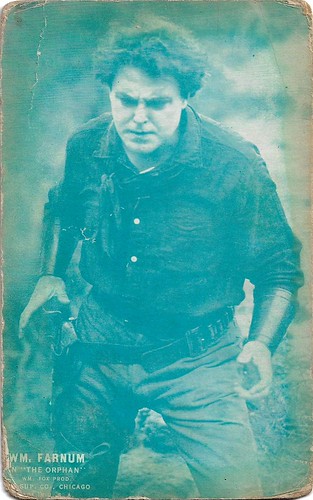
American postcard by Sup. Co., Chicago. Photo: William Fox Productions. Publicity still of William Farnum in The Orphan (J. Gordon Edwards, 1920).

Theda Bara. British postcard in the Lilywhite Photographic series. Photo: William Fox. Collection: Didier Hanson. Bara made more than 40 films between 1914 and 1926, but most were lost in the 1937 Fox vault fire.

Buck Jones. French postcard, no. 5031. Photo: Max Munn Autrey / Fox. With his famed horse Silver, Jones would make more than 160 films credits.
William Fox was born as Vilmos Fuchs (Fuchs is German for Fox) in 1879 in Tolcsva, Austria-Hungary (now Hungary). His Jewish family immigrated to the United States when William was nine months old and settled in New York City. Wilhelm never finished grammar school and worked as a newsboy and in the fur and garment industry as a youth. In 1900, he started his own fur company, which he sold in 1904 to purchase his first 146-seat nickelodeon in Brooklyn. Always more of an entrepreneur than a showman, he concentrated on acquiring and building cinemas. Fox personally oversaw the construction of many Fox Theatres in American cities including Atlanta, Detroit, Oakland, San Francisco and San Diego. He introduced organ accompaniment to the silent films shown in his cinemas and pioneered in designing theatres for the comfort of the patrons.
Like other industry pioneers, Fox moved into production and distribution to ensure a flow of product for his growing theatre chain. He founded Box Office Attractions, a film production/distribution company active from 1913 till 1914, when it was replaced by the William Fox Vaudeville Co. One of his first releases was the German film Die Augen des Ole Brandis/The Eyes of Ole Brandis (Stellan Rye, 1913) with Alexander Moissi and Paul Wegener. Fox became one of the most powerful of the independent exhibitors and distributors. In 1913, he led their fight against the Motion Picture Patents Company, an attempted monopoly of the industry by Thomas Edison and other film pioneers. The fight ended when the Supreme Court ruled in Fox's favour.
Beginning in 1914, New Jersey-based Fox bought films outright from the Balboa Amusement Producing Company in Long Beach, California, for distribution to his own theatres and then for rental to other theatres across the country. Examples are the short film dramas The Unexpected (1914) and The Rat (1914), both with Belle Bennett and Henry King. He formed the Fox Film Corporation on 1 February 1915 via the merger of his established production and distribution companies. The company's first film studio was leased in Fort Lee, New Jersey, where many other early film studios were based at the beginning of the 20th century.
In 1916, Fox moved his modest production operation to Hollywood, opening a studio on the corner of Sunset and Western. That began a period of tremendous growth for Fox, spurred by its two recent star discoveries, William Farnum and Theda Bara. William Farnum, celebrated on stage as the original Ben-Hur, became one of the highest paid stars in Hollywood. He received from William Fox $10,000 weekly for making such films as the action adventure Samson (Edgar Lewis, 1915). Through an adroit use of publicity, Fox transformed the unknown Theodosia Goodman from Cincinnati into the exotic film vamp Theda Bara. Publicists sent out press releases for her first film, A Fool There Was (Frank Powell, 1915), that Theda was the daughter of an artist and an Arabian princess, and that ‘Theda Bara’ was an anagram for ‘Arab Death’ - a far cry from her humble Jewish upbringing in Cincinnati. The following years, she starred in such exotic pictures as Salome (J. Gordon Edwards, 1918) and The Siren's Song (J. Gordon Edwards, 1919).
Under long-time production chief Winfield Sheehan, the studio turned out a winning combination of A-class star vehicles, like the Farnum and Bara films, alongside popular two-reel (50 minutes long) Westerns starring Tom Mix and Buck Jones. Mix was signed by Fox Films in 1917 and remained with them until 1928, averaging five or so films a year. A series of Westerns starring Mix grossed almost $1 million per film for Fox. His popularity eclipsed all other great cowboy stars of the silent era and he earned - and spent - millions. His early Fox Westerns include Durand of the Bad Lands (Richard Stanton, 1917), with Dustin Farnum – William’s brother, Western Blood (Lynn Reynolds, 1918), and The Coming of the Law (Arthur Rosson, 1919).
In the latter film, Buck Jones had a bit role. Producer William Fox put Jones under contract and decided to use him as a backup to Tom Mix. This led to his first leading role in The Last Straw (Denison Clift, Charles Swickard, 1920). Fox promoted Jones as a new Western star. He quickly climbed to the upper ranks of Western stardom, playing a more dignified, less gaudy hero than Mix in such Westerns as Straight from the Shoulder (Bernard J. Durning, 1921) and Against All Odds (Edmund Mortimer, 1924). With his famed horse Silver, Jones became one of the most successful and popular actors in the genre, and at one point he was receiving more fan mail than any actor in the world.
Fox Film reached a peak in the late silent era when its roster of staff directors included Raoul Walsh, Frank Borzage, John Ford, Howard Hawks, and F.W. Murnau. Winfield Sheehan tended to be a hands-off executive, so these directors enjoyed considerable control of their projects, which included such masterworks as What Price Glory (Raoul Walsh, 1926) with Victor McLaglen and Dolores del Rio, Seventh Heaven (Frank Borzage, 1927) with Janet Gaynor and Charles Farrell, and Sunrise (F.W. Murnau, 1927). Fox also produced solid genre work like Three Bad Men (John Ford, 1926) featuring George O'Brien and Lou Tellegen, Paid to Love (Howard Hawks, 1927) with George O’Brien and Virginia Valli, and A Girl in Every Port (Howard Hawks, 1928) with Victor McLaglen and Louise Brooks. Most of these films contained a musical score and sound effects, as Fox in 1926 and 1927 was vying with Warner Bros. to crack the sound barrier via its Movietone sound-on-film system.
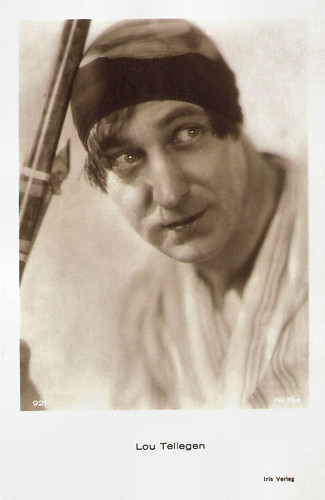
Lou Tellegen. Austrian postcard by Iris Verlag, no. 921. Photo: Fox Film.

Victor McLaglen. Austrian postcard by Iris Verlag, no. 5053. Photo: Max Munn Autrey / Fox. Publicity still for What Price Glory? (Raoul Walsh, 1926).
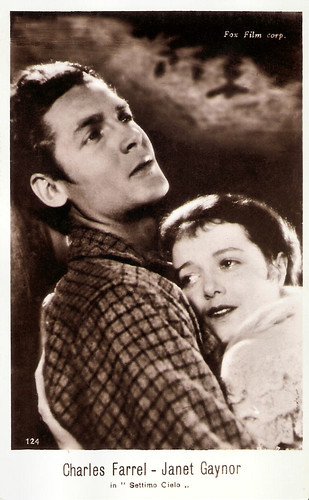
Charles Farrell and Janet Gaynor. Italian postcard offered by Cioccolata Lurati, no. 124. Photo: Fox. Publicity still for Seventh Heaven (Frank Borzage, 1927).
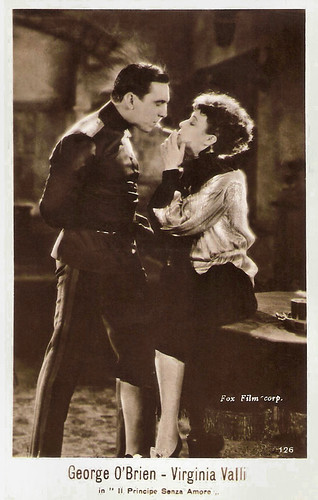
George O'Brien and Virginia Valli. Italian postcard by G.B. Falci, Milano, no. 126. Photo: Fox Film Corp. Publicity still for Paid to Love (1927).
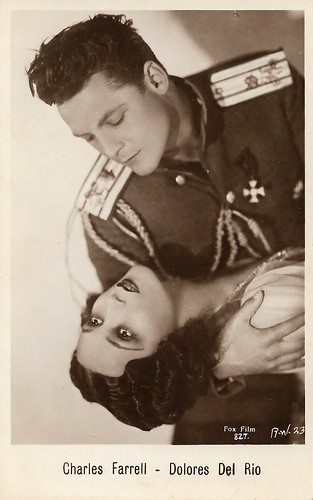
Charles Farrell and Dolores del Rio. Italian postcard by G.B. Falci, Milano, no. 827. Photo: Max Munn Autrey / Fox Film. Publicity still for The Red Dance (Raoul Walsh, 1928).
In 1925–1926, Fox purchased the rights to the work of Freeman Harrison Owens, the U.S. rights to the Tri-Ergon system invented by three German inventors, and the work of Theodore Case to create the Fox Movietone sound-on-film system, introduced in 1927 with the release of Sunrise (F.W. Murnau, 1927), starring George O'Brien and Janet Gaynor. The 1927 news series Movietone News was in fact the first commercially successful sound film. Sound-on-film systems such as Movietone and RCA Photophone soon became the standard, and competing sound-on-disc technologies, such as Warner Bros.' Vitaphone, fell into disuse. From 1928 to 1963, Fox Movietone News was one of the major newsreel series in the U.S.
In 1928 Fox completed construction on its new studio in Westwood (West Hollywood), dubbed ‘Movietone City’, and also began experimenting with widescreen and 70mm pictures like The Big Trail (Raoul Walsh, 1930), a spectacular Western starring John Wayne in his first significant leading role. The film flopped, weakening the market for A-class Westerns and relegating Wayne to a decade of B-Western roles. Ron Oliver at IMDb: “With very good acting and excellent production values, it lives up to its reputation as the talkies' first epic Western. John Wayne, pulled from obscurity for his first important movie role, looks impossibly young, but he immediately impresses with the natural charm & masculine authority he brings to the hero's role; he quietly dominates the film with the attributes which would someday make him a huge star.”
The flop added to William Fox's growing list of woes. In 1927, Marcus Loew, head of rival studio Metro-Goldwyn-Mayer, died, and control of MGM passed to his long-time associate, Nicholas Schenck. Fox saw an opportunity to expand his empire, and in 1929, with Schenck's assent, bought the Loew family's holdings in MGM. However, MGM studio bosses Louis B. Mayer and Irving Thalberg were outraged, since, despite their high posts in MGM, they were not shareholders. Mayer used his political connections to persuade the Justice Department to sue Fox for violating federal antitrust law. Because of the expense of converting 1,100 theatres to sound equipment, Fox’s empire crumbled. During this time, in the middle of 1929, Fox was badly hurt in an automobile accident. By the time he recovered, the stock market crash in the fall of 1929 had virtually wiped out his fortune, ending any chance of the Loews-Fox merger going through even if the Justice Department had given its blessing.
Fox lost control of the Fox Film Corporation in 1930 during a hostile takeover. A combination of the stock market crash, Fox's car accident injury, and government antitrust action forced him into a protracted seven-year struggle to fight off bankruptcy. At his bankruptcy hearing in 1936, he attempted to bribe judge John Warren Davis and committed perjury, for which he was sentenced to six months in prison. Fox retired from the film business. For many years Fox resented the way that Wall Street had forced him from control of his company. In 1933 he collaborated with the writer Upton Sinclair on a book 'Upton Sinclair Presents William Fox' in which Fox recounted his life his views on what he considered to be a conspiracy against him by Wall Street. For the remainder of his life he lived quietly in Long Island, New York, secure from his many patent holdings. There, he died more or less unnoticed in 1952 at the age of 73. No Hollywood producers came to his funeral. He is interred at Salem Fields Cemetery, Brooklyn. Vanda Krefft wrote the biography ‘The Man Who Made the Movies: The Meteoric Rise and Tragic Fall of William Fox’.
William Fox was replaced as president in 1930 by one of those creditors, Harley Clarke, while Sheehan remained head of production. There were some upbeat developments in the early sound era, especially on the talent front. Janet Gaynor, who burst to stardom in Seventh Heaven (Frank Borzage, 1927), and Sunrise (F.W. Murnau, 1927), enjoyed a successful transition to sound via two musical hits, Happy Days (Benjamin Stoloff, 1929) and Sunny Side Up (David Butler, 1929) opposite Charles Farrell. The recently signed Will Rogers, long-time film and vaudeville personality, suddenly surged to top stardom in the sound era. But these rising stars could not stem the impact of the Depression, and the studio's fortunes faded badly after Fox's ouster. In 1932 Clarke was replaced by Sidney Kent, who proved to be a capable chief executive but could not forestall the inevitable. In 1933 Fox West Coast Theatres, the studio's exhibition arm—and, in effect, its parent company—went into receivership. In 1935, Fox Film Corporation merged in 1935 with the upstart Twentieth Century Pictures to form 20th Century-Fox.
EFSP will do a post on 20th Century Fox next week. So, to be continued.
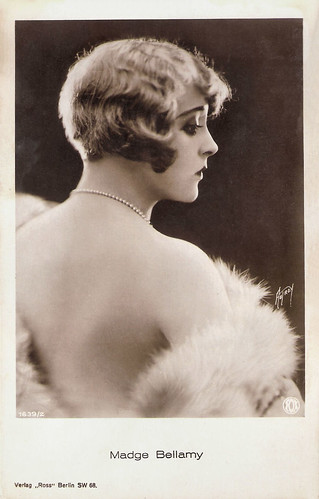
Madge Bellamy. German postcard by Ross Verlag, no. 1639/2, 1927-1928. Photo: Max Munn Autrey / Fox.
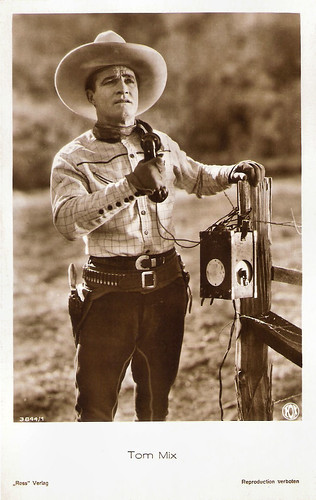
Tom Mix. German postcard by Ross Verlag, Berlin, no. 3844/1, 1928-1929. Photo: Fox.
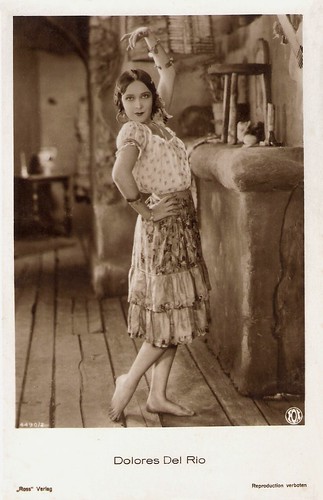
Dolores del Rio. German postcard by Ross Verlag, no. 4490/2, 1929-1930. Photo: Fox. Publicity still for The Loves of Carmen (Raoul Walsh, 1927).
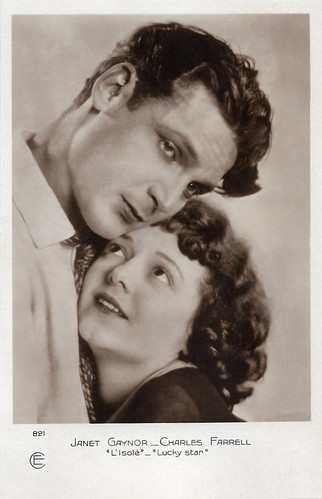
Janet Gaynor and Charles Farrell. French postcard by Cinémagazine Edition (CE), Paris, no. 821. Photo: Fox. Publicity still for Lucky Star (Frank Borzage, 1929).

George O'Brien. French postcard by A.N., Paris, no. 315. Photo: Max Munn Autrey / Fox Film. Collection: Didier Hanson.
Sources: Bob Shields (IMDb), Ron Oliver (IMDb), Denny Jackson (IMDb), Film Reference, Encyclopaedia Britannica, Wikipedia and IMDb.

Victor McLaglen. French postcard by J.R.P.R., Paris, no. 332. Photo: Max Munn Autrey / Fox. Publicity still for What Price Glory (Raoul Walsh, 1926).

Alexander Moissi. German postcard by Verlag Louis Blumenthal, Berlin, no. 2680.

American postcard by Sup. Co., Chicago. Photo: William Fox Productions. Publicity still of William Farnum in The Orphan (J. Gordon Edwards, 1920).

Theda Bara. British postcard in the Lilywhite Photographic series. Photo: William Fox. Collection: Didier Hanson. Bara made more than 40 films between 1914 and 1926, but most were lost in the 1937 Fox vault fire.

Buck Jones. French postcard, no. 5031. Photo: Max Munn Autrey / Fox. With his famed horse Silver, Jones would make more than 160 films credits.
Transforming unknown Theodosia Goodman into film vamp Theda Bara
William Fox was born as Vilmos Fuchs (Fuchs is German for Fox) in 1879 in Tolcsva, Austria-Hungary (now Hungary). His Jewish family immigrated to the United States when William was nine months old and settled in New York City. Wilhelm never finished grammar school and worked as a newsboy and in the fur and garment industry as a youth. In 1900, he started his own fur company, which he sold in 1904 to purchase his first 146-seat nickelodeon in Brooklyn. Always more of an entrepreneur than a showman, he concentrated on acquiring and building cinemas. Fox personally oversaw the construction of many Fox Theatres in American cities including Atlanta, Detroit, Oakland, San Francisco and San Diego. He introduced organ accompaniment to the silent films shown in his cinemas and pioneered in designing theatres for the comfort of the patrons.
Like other industry pioneers, Fox moved into production and distribution to ensure a flow of product for his growing theatre chain. He founded Box Office Attractions, a film production/distribution company active from 1913 till 1914, when it was replaced by the William Fox Vaudeville Co. One of his first releases was the German film Die Augen des Ole Brandis/The Eyes of Ole Brandis (Stellan Rye, 1913) with Alexander Moissi and Paul Wegener. Fox became one of the most powerful of the independent exhibitors and distributors. In 1913, he led their fight against the Motion Picture Patents Company, an attempted monopoly of the industry by Thomas Edison and other film pioneers. The fight ended when the Supreme Court ruled in Fox's favour.
Beginning in 1914, New Jersey-based Fox bought films outright from the Balboa Amusement Producing Company in Long Beach, California, for distribution to his own theatres and then for rental to other theatres across the country. Examples are the short film dramas The Unexpected (1914) and The Rat (1914), both with Belle Bennett and Henry King. He formed the Fox Film Corporation on 1 February 1915 via the merger of his established production and distribution companies. The company's first film studio was leased in Fort Lee, New Jersey, where many other early film studios were based at the beginning of the 20th century.
In 1916, Fox moved his modest production operation to Hollywood, opening a studio on the corner of Sunset and Western. That began a period of tremendous growth for Fox, spurred by its two recent star discoveries, William Farnum and Theda Bara. William Farnum, celebrated on stage as the original Ben-Hur, became one of the highest paid stars in Hollywood. He received from William Fox $10,000 weekly for making such films as the action adventure Samson (Edgar Lewis, 1915). Through an adroit use of publicity, Fox transformed the unknown Theodosia Goodman from Cincinnati into the exotic film vamp Theda Bara. Publicists sent out press releases for her first film, A Fool There Was (Frank Powell, 1915), that Theda was the daughter of an artist and an Arabian princess, and that ‘Theda Bara’ was an anagram for ‘Arab Death’ - a far cry from her humble Jewish upbringing in Cincinnati. The following years, she starred in such exotic pictures as Salome (J. Gordon Edwards, 1918) and The Siren's Song (J. Gordon Edwards, 1919).
Under long-time production chief Winfield Sheehan, the studio turned out a winning combination of A-class star vehicles, like the Farnum and Bara films, alongside popular two-reel (50 minutes long) Westerns starring Tom Mix and Buck Jones. Mix was signed by Fox Films in 1917 and remained with them until 1928, averaging five or so films a year. A series of Westerns starring Mix grossed almost $1 million per film for Fox. His popularity eclipsed all other great cowboy stars of the silent era and he earned - and spent - millions. His early Fox Westerns include Durand of the Bad Lands (Richard Stanton, 1917), with Dustin Farnum – William’s brother, Western Blood (Lynn Reynolds, 1918), and The Coming of the Law (Arthur Rosson, 1919).
In the latter film, Buck Jones had a bit role. Producer William Fox put Jones under contract and decided to use him as a backup to Tom Mix. This led to his first leading role in The Last Straw (Denison Clift, Charles Swickard, 1920). Fox promoted Jones as a new Western star. He quickly climbed to the upper ranks of Western stardom, playing a more dignified, less gaudy hero than Mix in such Westerns as Straight from the Shoulder (Bernard J. Durning, 1921) and Against All Odds (Edmund Mortimer, 1924). With his famed horse Silver, Jones became one of the most successful and popular actors in the genre, and at one point he was receiving more fan mail than any actor in the world.
Fox Film reached a peak in the late silent era when its roster of staff directors included Raoul Walsh, Frank Borzage, John Ford, Howard Hawks, and F.W. Murnau. Winfield Sheehan tended to be a hands-off executive, so these directors enjoyed considerable control of their projects, which included such masterworks as What Price Glory (Raoul Walsh, 1926) with Victor McLaglen and Dolores del Rio, Seventh Heaven (Frank Borzage, 1927) with Janet Gaynor and Charles Farrell, and Sunrise (F.W. Murnau, 1927). Fox also produced solid genre work like Three Bad Men (John Ford, 1926) featuring George O'Brien and Lou Tellegen, Paid to Love (Howard Hawks, 1927) with George O’Brien and Virginia Valli, and A Girl in Every Port (Howard Hawks, 1928) with Victor McLaglen and Louise Brooks. Most of these films contained a musical score and sound effects, as Fox in 1926 and 1927 was vying with Warner Bros. to crack the sound barrier via its Movietone sound-on-film system.

Lou Tellegen. Austrian postcard by Iris Verlag, no. 921. Photo: Fox Film.

Victor McLaglen. Austrian postcard by Iris Verlag, no. 5053. Photo: Max Munn Autrey / Fox. Publicity still for What Price Glory? (Raoul Walsh, 1926).

Charles Farrell and Janet Gaynor. Italian postcard offered by Cioccolata Lurati, no. 124. Photo: Fox. Publicity still for Seventh Heaven (Frank Borzage, 1927).

George O'Brien and Virginia Valli. Italian postcard by G.B. Falci, Milano, no. 126. Photo: Fox Film Corp. Publicity still for Paid to Love (1927).

Charles Farrell and Dolores del Rio. Italian postcard by G.B. Falci, Milano, no. 827. Photo: Max Munn Autrey / Fox Film. Publicity still for The Red Dance (Raoul Walsh, 1928).
William Fox's growing list of woes
In 1925–1926, Fox purchased the rights to the work of Freeman Harrison Owens, the U.S. rights to the Tri-Ergon system invented by three German inventors, and the work of Theodore Case to create the Fox Movietone sound-on-film system, introduced in 1927 with the release of Sunrise (F.W. Murnau, 1927), starring George O'Brien and Janet Gaynor. The 1927 news series Movietone News was in fact the first commercially successful sound film. Sound-on-film systems such as Movietone and RCA Photophone soon became the standard, and competing sound-on-disc technologies, such as Warner Bros.' Vitaphone, fell into disuse. From 1928 to 1963, Fox Movietone News was one of the major newsreel series in the U.S.
In 1928 Fox completed construction on its new studio in Westwood (West Hollywood), dubbed ‘Movietone City’, and also began experimenting with widescreen and 70mm pictures like The Big Trail (Raoul Walsh, 1930), a spectacular Western starring John Wayne in his first significant leading role. The film flopped, weakening the market for A-class Westerns and relegating Wayne to a decade of B-Western roles. Ron Oliver at IMDb: “With very good acting and excellent production values, it lives up to its reputation as the talkies' first epic Western. John Wayne, pulled from obscurity for his first important movie role, looks impossibly young, but he immediately impresses with the natural charm & masculine authority he brings to the hero's role; he quietly dominates the film with the attributes which would someday make him a huge star.”
The flop added to William Fox's growing list of woes. In 1927, Marcus Loew, head of rival studio Metro-Goldwyn-Mayer, died, and control of MGM passed to his long-time associate, Nicholas Schenck. Fox saw an opportunity to expand his empire, and in 1929, with Schenck's assent, bought the Loew family's holdings in MGM. However, MGM studio bosses Louis B. Mayer and Irving Thalberg were outraged, since, despite their high posts in MGM, they were not shareholders. Mayer used his political connections to persuade the Justice Department to sue Fox for violating federal antitrust law. Because of the expense of converting 1,100 theatres to sound equipment, Fox’s empire crumbled. During this time, in the middle of 1929, Fox was badly hurt in an automobile accident. By the time he recovered, the stock market crash in the fall of 1929 had virtually wiped out his fortune, ending any chance of the Loews-Fox merger going through even if the Justice Department had given its blessing.
Fox lost control of the Fox Film Corporation in 1930 during a hostile takeover. A combination of the stock market crash, Fox's car accident injury, and government antitrust action forced him into a protracted seven-year struggle to fight off bankruptcy. At his bankruptcy hearing in 1936, he attempted to bribe judge John Warren Davis and committed perjury, for which he was sentenced to six months in prison. Fox retired from the film business. For many years Fox resented the way that Wall Street had forced him from control of his company. In 1933 he collaborated with the writer Upton Sinclair on a book 'Upton Sinclair Presents William Fox' in which Fox recounted his life his views on what he considered to be a conspiracy against him by Wall Street. For the remainder of his life he lived quietly in Long Island, New York, secure from his many patent holdings. There, he died more or less unnoticed in 1952 at the age of 73. No Hollywood producers came to his funeral. He is interred at Salem Fields Cemetery, Brooklyn. Vanda Krefft wrote the biography ‘The Man Who Made the Movies: The Meteoric Rise and Tragic Fall of William Fox’.
William Fox was replaced as president in 1930 by one of those creditors, Harley Clarke, while Sheehan remained head of production. There were some upbeat developments in the early sound era, especially on the talent front. Janet Gaynor, who burst to stardom in Seventh Heaven (Frank Borzage, 1927), and Sunrise (F.W. Murnau, 1927), enjoyed a successful transition to sound via two musical hits, Happy Days (Benjamin Stoloff, 1929) and Sunny Side Up (David Butler, 1929) opposite Charles Farrell. The recently signed Will Rogers, long-time film and vaudeville personality, suddenly surged to top stardom in the sound era. But these rising stars could not stem the impact of the Depression, and the studio's fortunes faded badly after Fox's ouster. In 1932 Clarke was replaced by Sidney Kent, who proved to be a capable chief executive but could not forestall the inevitable. In 1933 Fox West Coast Theatres, the studio's exhibition arm—and, in effect, its parent company—went into receivership. In 1935, Fox Film Corporation merged in 1935 with the upstart Twentieth Century Pictures to form 20th Century-Fox.
EFSP will do a post on 20th Century Fox next week. So, to be continued.

Madge Bellamy. German postcard by Ross Verlag, no. 1639/2, 1927-1928. Photo: Max Munn Autrey / Fox.

Tom Mix. German postcard by Ross Verlag, Berlin, no. 3844/1, 1928-1929. Photo: Fox.

Dolores del Rio. German postcard by Ross Verlag, no. 4490/2, 1929-1930. Photo: Fox. Publicity still for The Loves of Carmen (Raoul Walsh, 1927).

Janet Gaynor and Charles Farrell. French postcard by Cinémagazine Edition (CE), Paris, no. 821. Photo: Fox. Publicity still for Lucky Star (Frank Borzage, 1929).

George O'Brien. French postcard by A.N., Paris, no. 315. Photo: Max Munn Autrey / Fox Film. Collection: Didier Hanson.
Sources: Bob Shields (IMDb), Ron Oliver (IMDb), Denny Jackson (IMDb), Film Reference, Encyclopaedia Britannica, Wikipedia and IMDb.
No comments:
Post a Comment